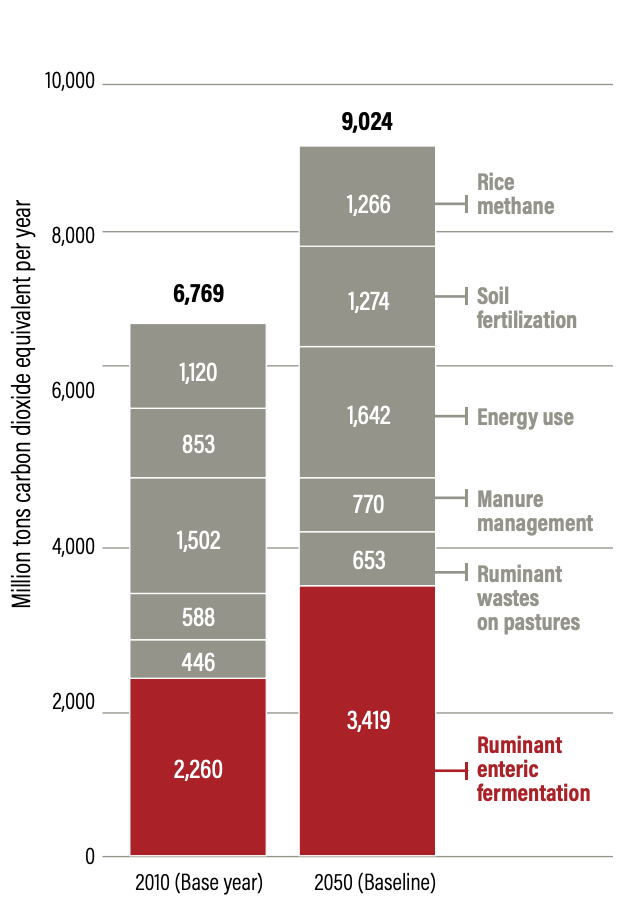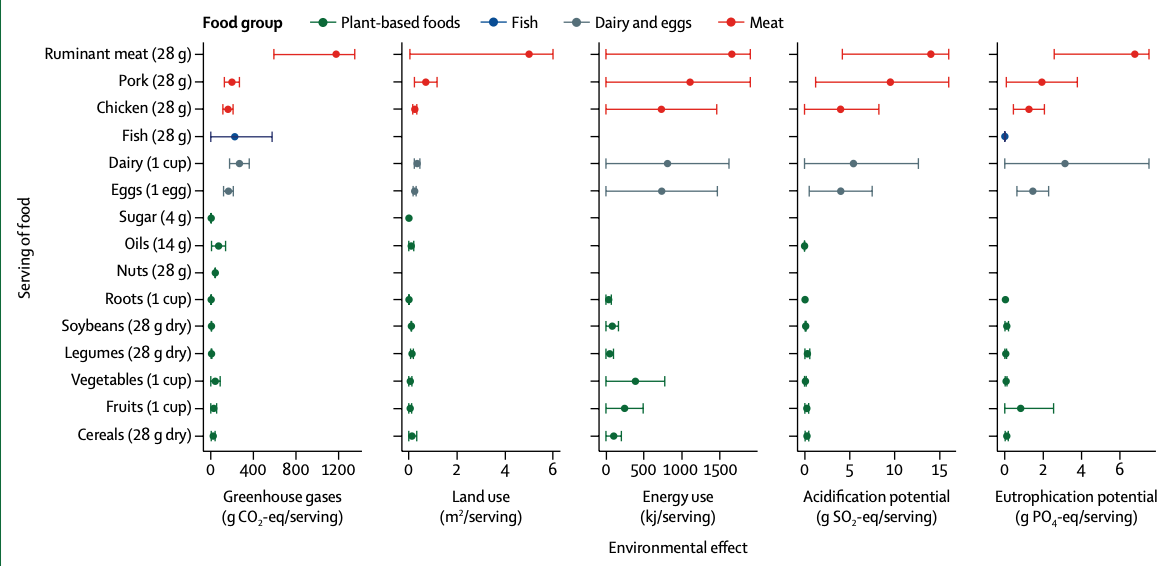BY ADAM GUARNERI
Adam Guarneri is a first-year International Development student and an Editor for SAIS Perspectives. The following article is adapted from his presentation about future food solutions in Professor Jessica Fanzo’s Global Food Systems and Policy course.
As the global population rises and more people in developing nations are escaping poverty, global food systems are facing a challenge in ensuring all citizens have adequate diets while facing the realities of climate change. According to FAO, livestock accounts for around 15 percent of global greenhouse gas (GHG) emissions.[i] Approximately 40 percent of that is linked to methane emitted in the digestive process, with beef and cattle milk production accounting for the majority of emissions. At the same time, the demand for meat and milk in 2050 is projected to grow by 73 and 58 percent, respectively, from their 2010 levels.[ii] As citizens’ incomes rise, their diets tend to change, causing fluctuations in demand for certain products such as meat and dairy. However, as the world faces a climate emergency, ensuring that evolving food systems are resilient in order to both supply consumers healthy, sustainable and affordable diets while mitigating climate change, is imperative. One solution being explored, to both reduce livestock GHG emissions and to allow markets to meet increasing demand for protein products, is to utilize algae in cattle feed.
Livestock generates approximately 50 percent of agricultural production GHG emissions (Figure 1). According to the World Resources Institute, in 2050 two-thirds of livestock emissions, and more than one-third of total agricultural production emissions, will be methane generated by “enteric fermentation.” [iii] Enteric fermentation refers to the process in which animals release methane, largely through belching. The science behind enteric fermentation can be simplified to the following: When a cow eats grass or other fibrous plants, microbes inside their rumen use carbon and hydrogen from the fermentation of consumed plants to produce methane, which escapes from the cow mainly through their mouth.
Figure 1 - Greenhouse gas emissions from Ag. Production, 2010 and 2050 (Source: WRI Report, 2019)
The challenge facing food systems is to ensure that while demand for food increases globally, methods to meet the demand are not increasingly contributing to environmental issues such as global warming and deforestation.
Cattle Impact on Climate Change and Algae as the Solution
The use of algae targets the negative effects that livestock GHG emissions have on the environment. Reducing methane from livestock, particularly cows, has long been a goal of scientists and policymakers but is especially tricky in balancing changing biology without causing harm, or altering the end product.
The specific seaweed utilized as a solution is called asparagopsis, which naturally grows in the world’s oceans. Asparagopsis has specialized gland cells that make and store bromoform, an organic compound. When it is freeze-dried and used as a supplement in cattle feed, the bromoform blocks carbon and hydrogen atoms from forming methane in the animal’s rumen. The cow then makes more propionate, a fatty acid that helps produce glucose in the metabolic process, allowing the animal to produce milk more efficiently. The technology has proven that utilizing asparagopsis reduces methane emissions and can also allow farmers to use less feed.[iv]
Lab tests and field trials have already shown that adding a small amount of seaweed to cows’ feed can reduce methane emitted by 98 percent. For comparison, most current solutions reduce methane outputs by 20 to 30 percent.[v]
Development and Scale
Numerous companies, largely concentrated in Australia, have already formed and are pursuing scaling the technology:
1. A company funded by the Government of Australia, FutureFeed, is working to make the algae feed commercially available for farmers to purchase and has raised capital through partnerships with other companies, such as the large Australian grocery chain Woolworths.
2. Sea Forest, another Australian company, claims to be the first company in the world to cultivate the seaweed at scale for commercial use.
3. Blue Ocean Barns, based in Hawaii, has backing from venture capital funds and is currently scaling up their proprietary production technology at strategic sites around the United States and launch sometime in 2021.[vi]
The scalability is proven to work both in-ocean and on land. According to FutureFeed, producing enough asparagopsis to feed 30 percent of the almost one million feedlots in Australia alone would require about 25,000 dry tonnes a year. With typical seaweed production rates at 30-50 tonnes of dry matter per hectare, this suggests that to supply 30 percent of the Australian feedlot will require approximately 2,000 hectares of seaweed farms.
Benefits of the Algae Technology
Beyond reducing methane emissions, the cultivation of algae can offer some secondary benefits. From a business perspective, growing algae used for the feed supplement can act as a carbon sink, and mitigate ocean acidification, since algae take in approximately five times as much carbon dioxide as land-based plants.[vii] Additionally, algae reduce nitrogen and phosphorus in the water (from fertilizers) and other environmental pollutants. A smaller firm, CH4 Global, is already partnering with fish farms in order to reduce pollutant runoff from aquaculture systems.[viii] Another company, Symbrosia, is in trial stages and wants to offer carbon offsets to consumers seeking to reduce methane emissions through feed.
Potential Drawbacks
Aside from some of the cons of the technology itself, including the difficulty in delivering the feed to grass-fed cattle that graze as well as the problem of scaling seaweed to combat the issue globally, the true problem is that there are much bigger impacts on the environment from cattle and other livestock than just GHG.
The major downside is that the solution does not solve the larger problem that the current cattle industry presents, namely huge negative footprints on land degradation, water usage, and land tenure issues (Figure 2).[ix]
Figure 2 - Environmental Effects Per Serving of Food Produced (Source: EAT-Lancet Commission Report on Food, 2019)
For example, cattle ranching in Brazil is responsible for approximately 80 percent of the deforestation of the Amazon rainforest.[x] By one estimate, worldwide agriculture has already cleared or converted 70 percent of grassland, 50 percent of the savanna, 45 percent of the temperate deciduous forest, and 27 percent of tropical forests.[xi]
Currently, feed production for livestock makes up 45 percent of the sector’s GHG emissions.[xii] The algae solution does not address looming questions posed by this issue of feed production itself: How does it help, for instance, with food waste and food insecurity globally? Is using half the global cereal production to meet the demand for animal meats ethical when we have people who are going hungry?
This is where potential political issues and opposition could arise. Cattle-producing countries, such as Australia, are leading the charge on research of this algae solution, but the idea of continuing meat production at current levels goes against the idea of a three-tiered approach to transforming the global food system to meeting food demand, supporting development, and protecting the Earth’s natural resources.
Utilizing algae in cattle feed can strengthen the resilience of the global food system by addressing the reality that demand for livestock continues to rise as the population grows. However, there are potential pitfalls of allowing livestock to be raised at current rates which could leave food systems vulnerable.
In the end, it is not realistic for one technology to solve every issue within the global food system. Being aware that this technology has major upsides while also understanding that it may disincentivize people from reducing their intake of meat is important, but so is building climate change-resilient food systems that are scalable and have proven benefits.
[i] Gerber, P.J., Steinfeld, H., Henderson, B., Mottet, A., Opio, C., Dijkman, J., Falcucci, A. & Tempio, G. 2013. Tackling climate change through livestock – A global assessment of emissions and mitigation opportunities. Food and Agriculture Organization of the United Nations (FAO), Rome.
[ii] Ibid.
[iii] Wait, Richard, Hanson, Craig, Ranganathan, Janet. 2019. World Resources Report: Creating a Sustainable Food Future. World Resources Institute (WRI), Washington DC. Pg. 316
[iv] Ibid.
[v] Schlossberg, Tatiana. “An Unusual Snack for Cows, a Powerful Fix for Climate.” The Washington Post. WP Company, November 27, 2020. https://www.washingtonpost.com/climate-solutions/2020/11/27/climate-solutions-seaweed-methane/?arc404=true
[vi] “Our Solution - Blue Ocean Barns.” Blue Ocean Barns. Accessed December 10, 2020. https://www.blueoceanbarns.com/new-index-1.
[vii] Cultivating Asparagopsis for Our Climate. Sea Forest. Accessed December 10, 2020. https://www.seaforest.com.au/.
[viii] CH4 Global. Accessed December 10, 2020. https://www.ch4global.com/.
[ix] Willett, W., Rockström, J., Loken, B., Springmann, M., Lang, T., Vermeulen, S., Garnett, T., Tilman, D., DeClerck, F., Wood, A. and Jonell, M., et al 2019. Food in the Anthropocene: the EAT–Lancet Commission on healthy diets from sustainable food systems. The Lancet, 393(10170), pp.447-492.
[x] “Unsustainable Cattle Ranching.” WWF. Accessed December 10, 2020. https://wwf.panda.org/discover/knowledge_hub/where_we_work/amazon/amazon_threats/unsustainable_cattle_ranching/.
[xi] Wait, Richard 2019.
[xii] Gerber, P.J. 2013.
PHOTO CREDIT: Free use image from Canva Pro.



